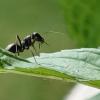2. Date of collection: 9/2/19
3. Habitat of collection: Dry area near a lot of black berry patches and other shrubs and tall grass.
4. Length (from head to gaster): 8 mm
5. Color, hue, pattern and texture: Very dark brown or red to a more reddish hue on petioles and legs. Shiny. You looks very dark colored though without bright lighting.
6. Distinguishing characteristics: Eyes look somewhat small but stick out of her head. Definitely has a small stinger.
7. Distinguishing behavior: I suspected she was semiclaustral or parasitic because of her gaster’s small size so I gave her some live fruit flies that had been slowed in the fridge with an outworld. She killed all seven in less than 15 minutes, using a stinger (which I was able to see while she was just in a test tube). Drank a lot of honey with a growing gaster and fruit flies were dry after a day of leaving them with her.
8. Nest description: n/a
9. Nuptial flight time and date: No way to be certain as she is definitely semi claustral from her behavior. I may have kidnapped some larvae’s mother.
I’m guessing that since she is semiclaustral, this queen is most likely of the genus Myrmica. Although I am not quite sure if Aphaenogaster has semiclaustral queens or not. I also appreciate any tips that anyone has on the care of either species would be great. I think I read somewhere that with Myrmica they wait until spring to start laying eggs.


















